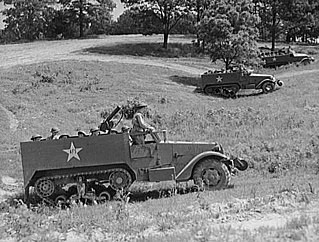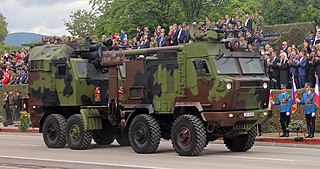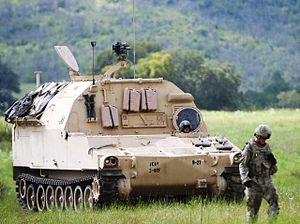
Self-propelled artillery is artillery equipped with its own propulsion system to move toward its firing position. Within the terminology are the self-propelled gun, self-propelled howitzer, self-propelled mortar, and rocket artillery. They are high mobility vehicles, usually based on continuous tracks carrying either a large field gun, howitzer, mortar, or some form of rocket/missile launcher. They are usually used for long-range indirect bombardment support on the battlefield.

The M109 is an American 155 mm turreted self-propelled howitzer, first introduced in the early 1960s to replace the M44. It has been upgraded a number of times, most recently to the M109A7. The M109 family is the most common Western indirect-fire support weapon of maneuver brigades of armored and mechanized infantry divisions.

The Merkava is a series of main battle tanks used by the Israel Defense Forces and the backbone of the IDF's armored corps. The tank began development in 1970, and its first generation, the Merkava mark I, entered official service in 1979. Four main variants have been deployed. As of 2023, the Merkava mark IV is the latest version. The Merkava was first used extensively in the 1982 Lebanon War. The name "Merkava" was derived from the IDF's initial development program name.

The AS-90, known officially as Gun Equipment 155 mm L131, is an armoured self-propelled artillery used by the British Army.

Hummel was a self-propelled gun based on the Geschützwagen III/IV chassis and armed with a 15 cm howitzer. It was used by the German Wehrmacht during the Second World War from early 1943 until the end of the war. Its ordnance inventory designation was Sd.Kfz. 165.

FV433, 105mm, Field Artillery, Self-Propelled "Abbot" is the self-propelled artillery, or more specifically self-propelled gun (SPG), variant of the British Army FV430 series of armoured fighting vehicles (AFVs), using much of the chassis of the FV430 but with a fully rotating turret at the rear housing the 105 mm gun and given the vehicle designation of FV433.

The M10 tank destroyer was an American tank destroyer of World War II. After US entry into World War II and the formation of the Tank Destroyer Force, a suitable vehicle was needed to equip the new battalions. By November 1941, the Army requested a vehicle with a gun in a fully rotating turret after other interim models were criticized for being too poorly designed. The prototype of the M10 was conceived in early 1942 and delivered in April that year. After appropriate changes to the hull and turret were made, the modified version was selected for production in June 1942 as the 3-inch Gun Motor Carriage M10. It mounted a 3-inch gun M7 in a rotating turret on a modified M4 Sherman tank chassis. An alternate model, the M10A1, which used the M4A3 variant chassis, was also produced. Production of the two models ran from September 1942 to December 1943 and October 1942 to November 1943, respectively.

The M3 half-track was an American armored personnel carrier half-track widely used by the Allies during World War II and in the Cold War. Derived from the M2 half-track car, the M3 was extensively produced, with about 15,000 standard M3s and more than 38,000 variant units manufactured.

The M107 175 mm self-propelled gun was used by the U.S. Army and U.S. Marine Corps from the early 1960s through to the late 1970s. It was part of a family of self-propelled artillery that also included the M110. It was intended to provide long-range fire support in an air-transportable system. It was exported to several other countries including Germany, South Korea, Spain, Greece, Iran, Israel, Italy, the Netherlands, the United Kingdom, and Turkey. The M107's combat history in U.S. service was limited to the Vietnam War; it also saw extensive combat use in Israeli service. The M107 shared many components with, and in many cases was replaced by, later versions of the M110 203 mm howitzer. Although withdrawn from U.S. service in the late 1970s, it continues in service with some armies as of 2019.

The AIFV is a US tracked light armored vehicle that serves as an infantry fighting vehicle (IFV) in the armies of several countries. It is a development of the M113A1 armored personnel carrier.

Fälthaubits 77 or FH77 is a Swedish 155 mm howitzer, developed and manufactured by Bofors. It is also colloquially known as the Bofors gun in India. There were several versions, the original with a 38 calibre barrel and sliding block mechanism, the export version FH77 B version with a 39 calibre barrel and an interrupted ogival screw breech. For the demonstrator of the Archer Artillery System, some FH77A were modified into FH 77 AD L/45, while the series production were FH77Bs rebuilt into FH77 BW L/52. The carriage was also used for the "12 cm rörlig kustartilleripjäs m/80 KARIN", used in the Swedish coastal artillery.

The Nora B-52 is a 155 mm self-propelled howitzer developed by Military Technical Institute and manufactured by Yugoimport SDPR in Velika Plana, Serbia.

The PLZ-45 or Type 88 is a 155 mm self-propelled howitzer designed by Su Zhezi of 674 Factory, and developed by Norinco, 123 Factory, 127 Factory, 674 Factory and the Beijing Institute of Technology in the early 1990s for the export market. It is based on Norinco's Type 89 (PLL-01) 155 mm/45-calibre towed gun-howitzer.

SP70 self-propelled gun was a scheme set up by several European nations including the UK, Germany and Italy beginning in 1973. The project was shelved in favour of the US M109, which was already in service. The SP70 was 'outgunned' on several occasions by the M109 and further development was cancelled in the 1980s.

The Type 90 is an armoured fighting vehicle produced by Chinese company Norinco; it is the successor for the Type 85 AFV of which it uses some components. The Type 90 series was developed for export, and consists of at least 10 different types; its industrial index is YW535.

The AMX-30 AuF1 is a French self-propelled gun vehicle currently in use by the armies of France and Saudi Arabia. It replaced the former Mk F3 155mm in French Army service. The AuF1 primary advance is that it incorporates full armor and nuclear-biological-chemical (NBC) protection for its crew of four, while the former Mk F3 155mm offered no protection and could carry only two of its four crew members. The AuF1 saw combat with the Iraqi Army in the Iran–Iraq War.
155 mm is a NATO-standard artillery caliber that is used in many field guns, howitzers, and gun-howitzers. It is defined in AOP-29 part 1 with reference to STANAG 4425.

The Artillery Gun Module is an air-portable 155 mm self-propelled howitzer designed by Krauss-Maffei Wegmann. It is based on technology used in the German Army Panzerhaubitze 2000 system, to provide more air portable self-propelled artillery, transportable by Airbus A400 aircraft.

The Mk 61 105 mm Self-Propelled Howitzer was a French self-propelled artillery piece designed and built during the late 1950s for the French Army.



















